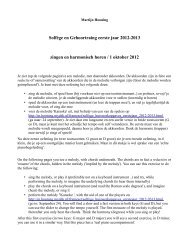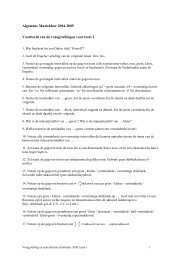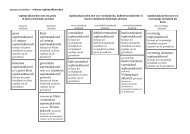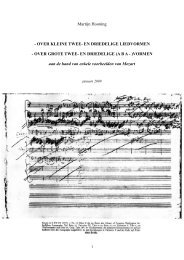Martijn Hooning SOME REMARKS ON SONATA FORM with an ...
Martijn Hooning SOME REMARKS ON SONATA FORM with an ...
Martijn Hooning SOME REMARKS ON SONATA FORM with an ...
Create successful ePaper yourself
Turn your PDF publications into a flip-book with our unique Google optimized e-Paper software.
Normally<br />
– the exposition is repeated; we find a repetition sign at the end of the exposion (<strong>an</strong>d also,<br />
when the sonata contains a slow introduction at the beginning of the exposition)<br />
– development section <strong>an</strong>d recapitulation are repeated together; we find a repetition sign at<br />
the beginning of the development <strong>an</strong>d at the end of the recapitulation.<br />
From Beethoven the second repeat (development+recapitulation) often is omitted;<br />
sometimes even the exposition is not repeated (fromBeethoven's late work).<br />
In a Classical sonata the themes are more or less like characters in a play: the themetical sections<br />
are best recognizable, are the easiest to remember, <strong>an</strong>d often differ from the other sections by<br />
having a clearer, more 'fixed' structure - for inst<strong>an</strong>ce a clear grouping like 4 + 4 .The nonthemetical<br />
sections (tr<strong>an</strong>sition, closing section) on the contrary often have a more 'loose' structure. 5<br />
When a second group is consisting of more then one section very often the first section is the most<br />
'characteristic', <strong>an</strong>d sounding more 'import<strong>an</strong>t' then the second or (eventual) third section. The first<br />
section therefore often is perceived as the 'real second theme'.<br />
Before speaking about the concrete form of the first movement of Beethoven's First Symphony, I<br />
would like to discuss some general issues connected <strong>with</strong> Beethoven's way of composing, <strong>an</strong>d<br />
especially <strong>with</strong> his ways to create coherence in a composition. In m<strong>an</strong>y pieces of Beethoven we c<strong>an</strong><br />
observe that some very simple material is used (motifs, or even a kind of 'pre-stages' of motifs, as<br />
for example: groups of intervals, melodic direction <strong>an</strong>d the like). These then are often used <strong>an</strong>d resed<br />
in various sections of the form, <strong>an</strong>d therefore links are created between these sections. Such<br />
elements are often almost “primitive”: for example: a circular motion around one tone, excessive<br />
use of a certain inversion of chords, a specific scale figure.. 6<br />
In the First Symphony we certainly c<strong>an</strong> find such elements. We c<strong>an</strong> describe them as follows:<br />
– the motion from leading tone to root, in other words: <strong>an</strong> ascending semitone (7 → 1), which<br />
is also often developing into <strong>an</strong> ascending chromatic scale:<br />
5 Erwin Ratz speaks in his Formenlehre-book of “fest gefügte” ('strongly jointed') <strong>an</strong>d “locker gefügte” ('loosely<br />
jointed') passages.<br />
6 A good example is the first movement of the Sonata in D minor “the tempest”: in this movement 6-chords, <strong>an</strong>d turns<br />
around a tone are const<strong>an</strong>tly used.<br />
8






